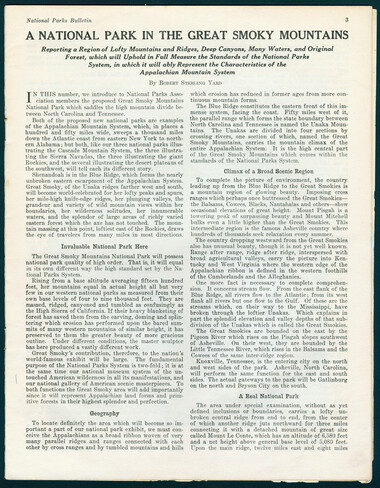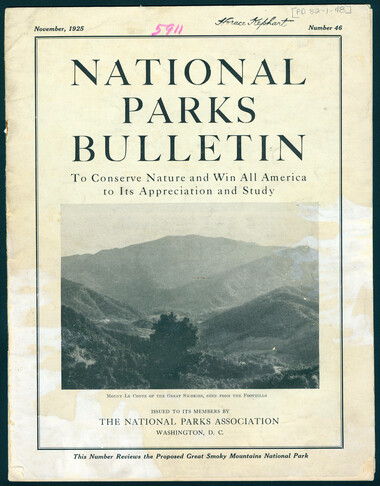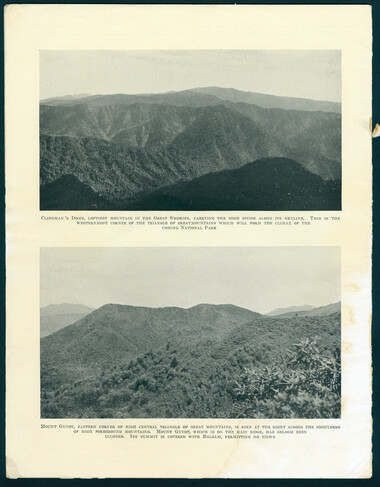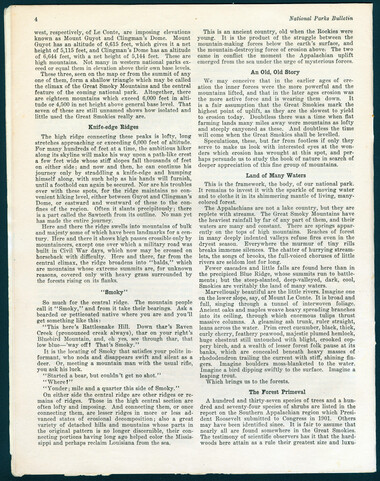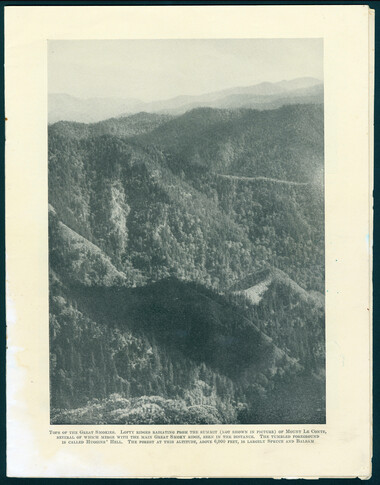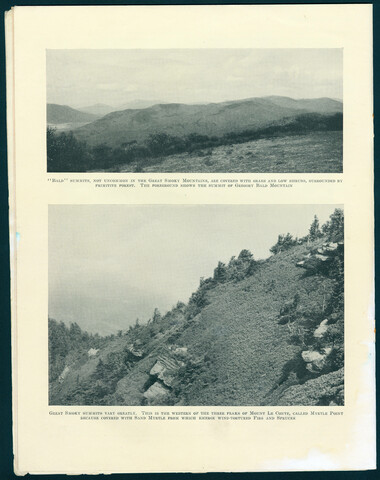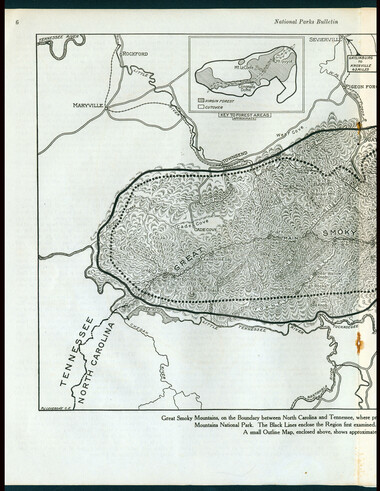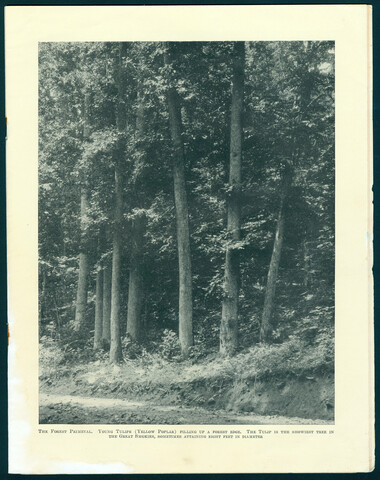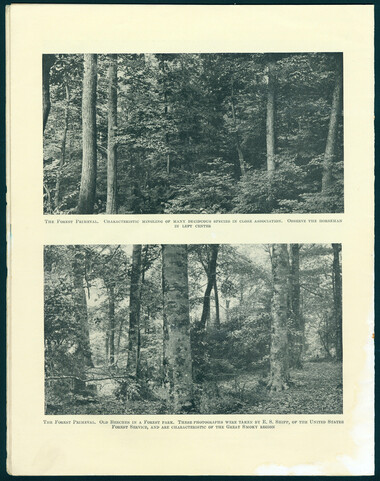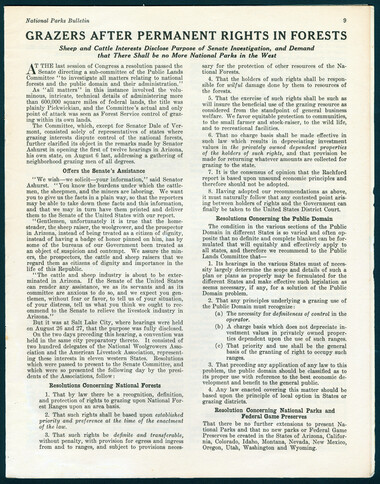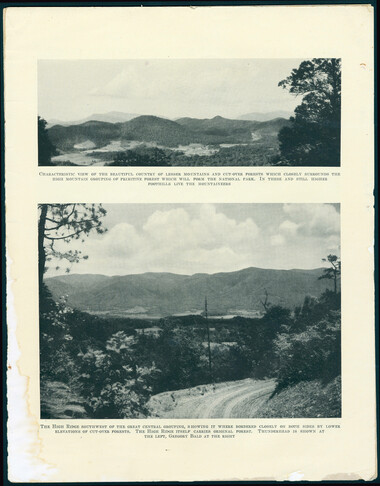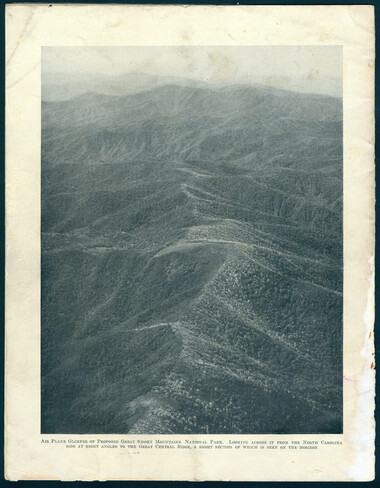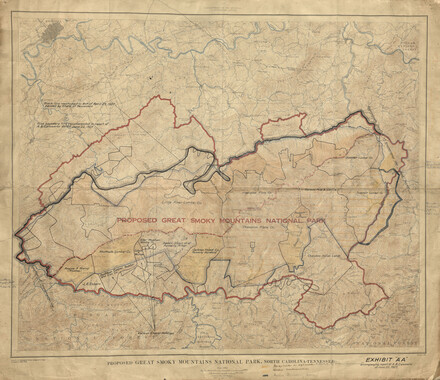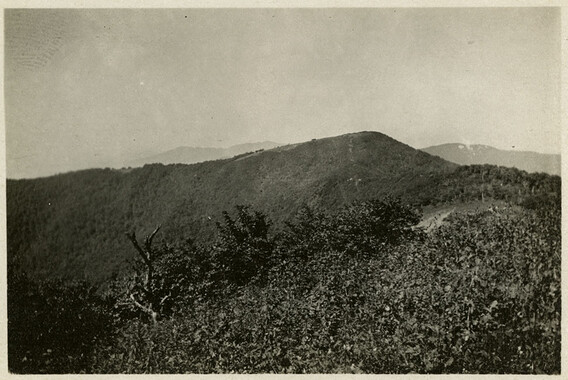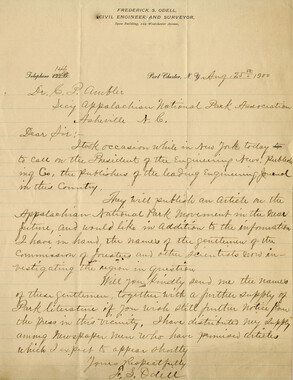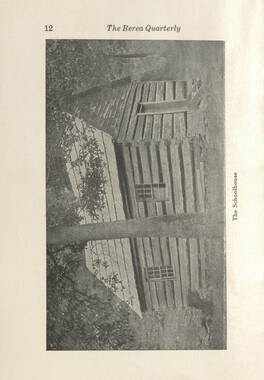Western Carolina University (20)
View all
- Canton Champion Fibre Company (2308)
- Cherokee Traditions (293)
- Civil War in Southern Appalachia (165)
- Craft Revival (1942)
- Great Smoky Mountains - A Park for America (2683)
- Highlights from Western Carolina University (430)
- Horace Kephart (941)
- Journeys Through Jackson (154)
- LGBTQIA+ Archive of Jackson County (7)
- Oral Histories of Western North Carolina (314)
- Picturing Appalachia (6592)
- Stories of Mountain Folk (413)
- Travel Western North Carolina (160)
- Western Carolina University Fine Art Museum Vitreograph Collection (129)
- Western Carolina University Herbarium (92)
- Western Carolina University: Making Memories (708)
- Western Carolina University Publications (2283)
- Western Carolina University Restricted Electronic Theses and Dissertations (146)
- Western North Carolina Regional Maps (71)
- World War II in Southern Appalachia (131)
University of North Carolina Asheville (6)
View all
- Appalachian National Park Association (53)
- Berry, Walter (76)
- Champion Fibre Company (5)
- Fromer, Irving Rhodes, 1913-1994 (70)
- Grant, George Alexander, 1891-1964 (96)
- Kephart, Horace, 1862-1931 (23)
- Masa, George, 1881-1933 (17)
- North Carolina Park Commission (105)
- Roth, Albert, 1890-1974 (142)
- Schenck, Carl Alwin, 1868-1955 (1)
- Stearns, I. K. (2)
- Thompson, James Edward, 1880-1976 (45)
- Weaver, Zebulon, 1872-1948 (55)
- Wilburn, Hiram Coleman, 1880-1967 (72)
- Allanstand Cottage Industries (0)
- Bennett, Kelly, 1890-1974 (0)
- Brasstown Carvers (0)
- Cain, Doreyl Ammons (0)
- Carver, George Washington, 1864?-1943 (0)
- Cathey, Joseph, 1803-1874 (0)
- Champion Paper and Fibre Company (0)
- Cherokee Indian Fair Association (0)
- Cherokee Language Program (0)
- Crittenden, Lorraine (0)
- Crowe, Amanda (0)
- Edmonston, Thomas Benton, 1842-1907 (0)
- Ensley, A. L. (Abraham Lincoln), 1865-1948 (0)
- George Butz (BFS 1907) (0)
- Goodrich, Frances Louisa (0)
- Heard, Marian Gladys (0)
- Kephart, Calvin, 1883-1969 (0)
- Kephart, Laura, 1862-1954 (0)
- Laney, Gideon Thomas, 1889-1976 (0)
- McElhinney, William Julian, 1896-1953 (0)
- Niggli, Josephina, 1910-1983 (0)
- Osborne, Kezia Stradley (0)
- Owens, Samuel Robert, 1918-1995 (0)
- Penland Weavers and Potters (0)
- Rhodes, Judy (0)
- Roberts, Vivienne (0)
- Sherrill's Photography Studio (0)
- Smith, Edward Clark (0)
- Southern Highland Handicraft Guild (0)
- Southern Highlanders, Inc. (0)
- Stalcup, Jesse Bryson (0)
- United States. Indian Arts and Crafts Board (0)
- USFS (0)
- Vance, Zebulon Baird, 1830-1894 (0)
- Western Carolina College (0)
- Western Carolina Teachers College (0)
- Western Carolina University (0)
- Western Carolina University. Mountain Heritage Center (0)
- Whitman, Walt, 1819-1892 (0)
- Williams, Isadora (0)
- 1810s (1)
- 1840s (1)
- 1850s (2)
- 1860s (3)
- 1870s (4)
- 1880s (7)
- 1890s (64)
- 1900s (294)
- 1910s (227)
- 1920s (461)
- 1930s (1501)
- 1940s (82)
- 1950s (15)
- 1960s (13)
- 1970s (47)
- 1980s (14)
- 1990s (17)
- 2000s (31)
- 2010s (1)
- 1600s (0)
- 1700s (0)
- 1800s (0)
- 1820s (0)
- 1830s (0)
- 2020s (0)
- Appalachian Region, Southern (80)
- Asheville (N.C.) (1)
- Avery County (N.C.) (6)
- Blount County (Tenn.) (145)
- Buncombe County (N.C.) (204)
- Cherokee County (N.C.) (10)
- Clay County (N.C.) (3)
- Graham County (N.C.) (108)
- Great Smoky Mountains National Park (N.C. and Tenn.) (416)
- Haywood County (N.C.) (263)
- Henderson County (N.C.) (13)
- Jackson County (N.C.) (58)
- Knox County (Tenn.) (17)
- Knoxville (Tenn.) (8)
- Lake Santeetlah (N.C.) (10)
- Macon County (N.C.) (25)
- Madison County (N.C.) (14)
- McDowell County (N.C.) (5)
- Mitchell County (N.C.) (7)
- Polk County (N.C.) (2)
- Qualla Boundary (22)
- Rutherford County (N.C.) (16)
- Swain County (N.C.) (513)
- Transylvania County (N.C.) (36)
- Watauga County (N.C.) (2)
- Waynesville (N.C.) (2)
- Yancey County (N.C.) (34)
- Aerial Views (3)
- Articles (1)
- Artifacts (object Genre) (4)
- Clippings (information Artifacts) (77)
- Drawings (visual Works) (174)
- Envelopes (2)
- Financial Records (9)
- Fliers (printed Matter) (34)
- Guidebooks (1)
- Interviews (11)
- Land Surveys (102)
- Letters (correspondence) (219)
- Manuscripts (documents) (91)
- Maps (documents) (69)
- Memorandums (14)
- Minutes (administrative Records) (20)
- Negatives (photographs) (198)
- Newsletters (12)
- Paintings (visual Works) (1)
- Pen And Ink Drawings (1)
- Photographs (1657)
- Portraits (23)
- Postcards (15)
- Publications (documents) (107)
- Scrapbooks (3)
- Sound Recordings (7)
- Speeches (documents) (11)
- Transcripts (46)
- Aerial Photographs (0)
- Albums (books) (0)
- Biography (general Genre) (0)
- Cards (information Artifacts) (0)
- Crafts (art Genres) (0)
- Depictions (visual Works) (0)
- Design Drawings (0)
- Facsimiles (reproductions) (0)
- Fiction (general Genre) (0)
- Glass Plate Negatives (0)
- Internegatives (0)
- Newspapers (0)
- Occupation Currency (0)
- Periodicals (0)
- Personal Narratives (0)
- Poetry (0)
- Programs (documents) (0)
- Questionnaires (0)
- Sheet Music (0)
- Slides (photographs) (0)
- Specimens (0)
- Text Messages (0)
- Tintypes (photographs) (0)
- Video Recordings (physical Artifacts) (0)
- Vitreographs (0)
- Appalachian National Park Association Records (336)
- Carlos C. Campbell Collection (198)
- Cataloochee History Project (65)
- George Masa Collection (89)
- Hiram C. Wilburn Papers (28)
- Historic Photographs Collection (236)
- Horace Kephart Collection (126)
- Humbard Collection (33)
- Jim Thompson Collection (44)
- Love Family Papers (11)
- Map Collection (12)
- R.A. Romanes Collection (10)
- Smoky Mountains Hiking Club Collection (616)
- Zebulon Weaver Collection (107)
- A.L. Ensley Collection (0)
- Appalachian Industrial School Records (0)
- Axley-Meroney Collection (0)
- Bayard Wootten Photograph Collection (0)
- Bethel Rural Community Organization Collection (0)
- Blumer Collection (0)
- C.W. Slagle Collection (0)
- Canton Area Historical Museum (0)
- Cherokee Studies Collection (0)
- Daisy Dame Photograph Album (0)
- Daniel Boone VI Collection (0)
- Doris Ulmann Photograph Collection (0)
- Elizabeth H. Lasley Collection (0)
- Elizabeth Woolworth Szold Fleharty Collection (0)
- Frank Fry Collection (0)
- Gideon Laney Collection (0)
- Hazel Scarborough Collection (0)
- Hunter and Weaver Families Collection (0)
- I. D. Blumenthal Collection (0)
- Isadora Williams Collection (0)
- Jesse Bryson Stalcup Collection (0)
- John B. Battle Collection (0)
- John C. Campbell Folk School Records (0)
- John Parris Collection (0)
- Judaculla Rock project (0)
- Kelly Bennett Collection (0)
- Major Wiley Parris Civil War Letters (0)
- McFee-Misemer Civil War Letters (0)
- Mountain Heritage Center Collection (0)
- Norburn - Robertson - Thomson Families Collection (0)
- Pauline Hood Collection (0)
- Pre-Guild Collection (0)
- Qualla Arts and Crafts Mutual Collection (0)
- Rosser H. Taylor Collection (0)
- Samuel Robert Owens Collection (0)
- Sara Madison Collection (0)
- Sherrill Studio Photo Collection (0)
- Stories of Mountain Folk - Radio Programs (0)
- The Reporter, Western Carolina University (0)
- Venoy and Elizabeth Reed Collection (0)
- WCU Gender and Sexuality Oral History Project (0)
- WCU Mountain Heritage Center Oral Histories (0)
- WCU Oral History Collection - Mountain People, Mountain Lives (0)
- WCU Students Newspapers Collection (0)
- Western North Carolina Tomorrow Black Oral History Project (0)
- William Williams Stringfield Collection (0)
- Appalachian Trail (19)
- Church buildings (9)
- Civilian Conservation Corps (U.S.) (91)
- Dams (20)
- Floods (1)
- Forest conservation (11)
- Forests and forestry (42)
- Great Smoky Mountains National Park (N.C. and Tenn.) (64)
- Hunting (2)
- Logging (25)
- Maps (74)
- North Carolina -- Maps (5)
- Postcards (15)
- Railroad trains (8)
- Sports (4)
- Storytelling (2)
- Waterfalls -- Great Smoky Mountains (N.C. and Tenn.) (39)
- African Americans (0)
- Artisans (0)
- Cherokee art (0)
- Cherokee artists -- North Carolina (0)
- Cherokee language (0)
- Cherokee pottery (0)
- Cherokee women (0)
- College student newspapers and periodicals (0)
- Dance (0)
- Education (0)
- Folk music (0)
- Forced removal, 1813-1903 (0)
- Gender nonconformity (0)
- Landscape photography (0)
- Mines and mineral resources (0)
- Paper industry (0)
- Pottery (0)
- Rural electrification -- North Carolina, Western (0)
- School integration -- Southern States (0)
- Segregation -- North Carolina, Western (0)
- Slavery (0)
- Weaving -- Appalachian Region, Southern (0)
- Wood-carving -- Appalachian Region, Southern (0)
- World War, 1939-1945 (0)
- Sound (7)
- StillImage (2088)
- Text (655)
- MovingImage (0)
National Parks Bulletin
Item
Item’s are ‘child’ level descriptions to ‘parent’ objects, (e.g. one page of a whole book).
-
-
National Parks Bulletin A NATIONAL PARK IN THE GREAT SMOKY MOUNTAINS Reporting a Region of Lofty Mountains and Ridges, Deep Canyons, Many Waters, and Original Forest, which will Uphold in Full Measure the Standards of the National Parks System, in which it will ably Represent the Characteristics of the Appalachian Mountain System By Robert Sterling Yard IN THIS number, we introduce to National Parks Association members the proposed Great Smoky Mountains National Park which saddles the high mountain divide between North Carolina and Tennessee. Both of the proposed new national parks are examples of the Appalachian Mountain System, which, in places a hundred and fifty miles wide, sweeps a thousand miles down the Atlantic coast from eastern New York to northern Alabama; but both, like our three national parks illustrating the Cascade Mountain System, the three illustrating the Sierra Navadas, the three illustrating the giant Rockies, and the several illustrating the desert plateaus of the southwest, will tell each its different story. Shenandoah is in the Blue Ridge, which forms the nearly unbroken eastern escarpment of the Appalachian System. Great Smoky, of the Unaka ridges farther west and south, will become world-celebrated for her lofty peaks and spurs, her mile-high knife-edge ridges, her plunging valleys, the grandeur and variety of wild mountain views within her boundaries, her wilderness solitudes, her innumerable waters, and the splendor of large areas of richly varied eastern forest which the axe has not touched. The mountain massing at this point, loftiest east of the Rockies, draws the eye of travelers from many miles in most directions. Invaluable National Park Here The Great Smoky Mountains National Park will possess national park quality of high order. That is, it will equal in its own different way the high standard set by the National Parks System. Rising from a base altitude averaging fifteen hundred feet, her mountains equal in actual height all but very few in our western national parks as measured from their own base levels of four to nine thousand feet. They are massed, ridged, canyoned and tumbled as confusingly as the High Sierra of California. If their heavy blanketing of forest has saved them from the carving, doming and splintering which erosion has performed upon the bared summits of many western mountains of similar height, it has preserved to them the greater beauty of more gracious outline. Under different conditions, the master sculptor has here produced a vastly different work. Great Smoky's contribution, therefore, to the nation's world-famous exhibit will be large. The fundamental purpose of the National Parks System is two-fold; it is at the same time our national museum system of the untouched American wilderness in all its manifestations, and our national gallery of American scenic masterpieces. To both functions the Great Smoky area will add importantly since it will represent Appalachian land forms and primitive forests in their highest splendor and perfection. Geography To locate definitely the area which will become so important a part of our national park exhibit, we must conceive the Appalachians as a broad ribbon woven of very many parallel ridges and ranges connected with each other by cross ranges and by tumbled mountains and hills which erosion has reduced in former ages from more continuous mountain forms. The Blue Ridge constitutes the eastern front of this immense system, facing the coast. Fifty miles west of it, the parallel range which forms the state boundary between North Carolina and Tennessee is named the Unaka Mountains. The Unakas are divided into four sections by crossing rivers, one section of which, named the Great Smoky Mountains, carries the mountain climax of the entire Appalachian System. It is the high central part of the Great Smoky Mountains which comes within the standards of the National Parks System. Climax of a Broad Scenic Region To complete the picture of environment, the country leading up from the Blue Ridge to the Great Smokies is a mountain region of glowing beauty. Imposing cross ranges which perhaps once buttressed the Great Smokies— the Balsams, Cowees, Blacks, Nantahalas and others—show occasional elevations of great height. Mount Pisgah is a towering peak of surpassing beauty and Mount Mitchell bulks even a little higher than the Great Smokies. This intermediate region is the famous Asheville country where hundreds of thousands seek relaxation every summer. The country dropping westward from the Great Smokies also has unusual beauty, though it is not yet well known. Range after range, ridge after ridge, interspersed with broad agricultural valleys, carry the picture into Kentucky and West Virginia where the western edge of the Appalachian ribbon is defined in the western foothills of the Cumberlands and the Alleghanies. One more fact is necessary to complete comprehension. It concerns stream flow. From the east flank of the Blue Ridge, all rivers flow to the Atlantic; from its west flank all rivers but one flow to the Gulf. Of these are the streams which, on their way to the Mississippi, have broken through the loftier Unakas. Which explains in part the splendid elevation and valley depths of that subdivision of the Unakas which is called the Great Smokies. The Great Smokies are bounded on the east by the Pigeon River which rises on the Pisgah slopes southwest of Asheville. On their west, they are bounded by the Little Tennessee River, which rises in the Balsams and the Cowees of the same inter-ridge region. Knoxville, Tennessee, is the entering city on the north and west sides of the park. Asheville, North Carolina, will perform the same function for the east and south sides. The actual gateways to the park will be Gatlinburg on the north and Bryson City on the south. A Real National Park The area under special examination, without as yet defined inclusions or boundaries, carries a lofty unbroken central ridge from end to end, from the center of which another ridge juts northward for three miles connecting it with a detached mountain of great size called Mount Le Conte, which has an altitude of 6,580 feet and a net height above general base level of 5,080 feet. Upon the main ridge, twelve miles east and eight miles
Object
Object’s are ‘parent’ level descriptions to ‘children’ items, (e.g. a book with pages).
-
The subtitle of National Parks Bulletin (No. 46), edited by Robert Sterling Yard, reads: “To Conserve Nature and Win All America to its Appreciation and Study” and includes a cover caption indicating its focus on the “Proposed Great Smoky Mountains National Park.” This subtitle and the contents cover issues of conservation, including the “Importance of Government Protection” and a statement “In Support of Secretary Work’s Policy.” With titles sounding defensive, the brochure later reveals that sheep and cattle interests demand “no more national parks.” The bulletin also outlines the purposes of the National Parks Association, a membership organization located in Washington DC.
-
